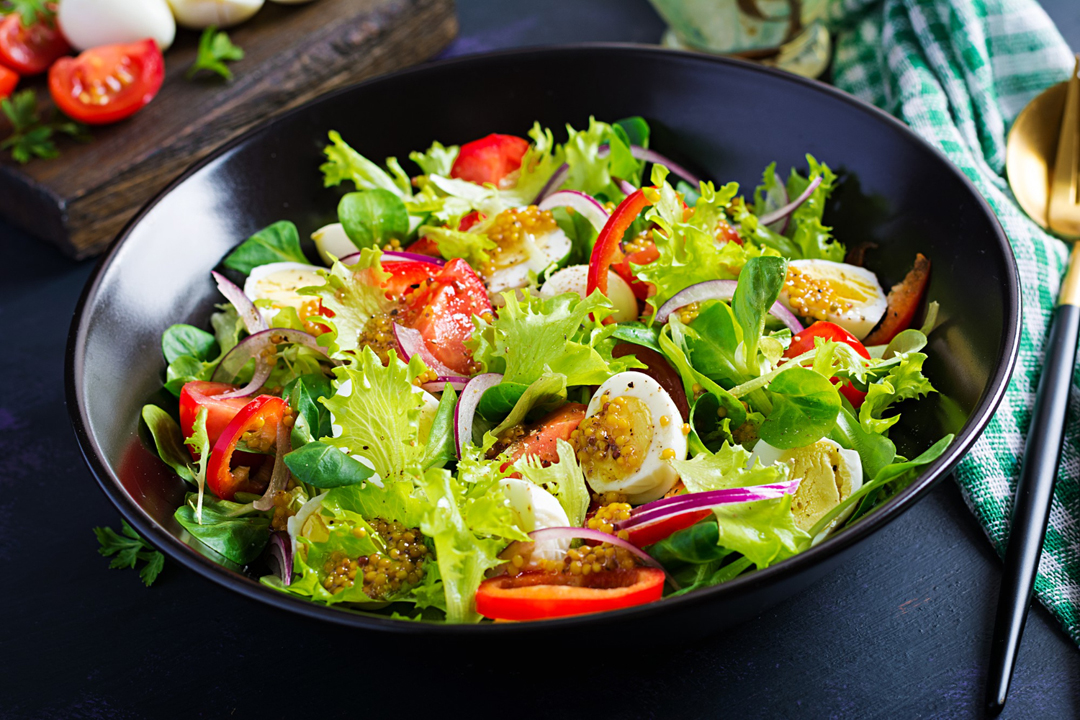
A healthy salad full of nutritious leafy greens, crunchy veggies and a delicious dressing can be a versatile and wholesome meal for breakfast, lunch, or dinner. When prepared right, a salad is a whole meal in itself containing protein, fats, fibre, healthy carbs, vitamins, and minerals that can keep you satiated for hours. And the best part is you actually don’t need a fixed recipe. By ensuring that you incorporate the important components of a salad, you cannot just easily make your salad but also interchange the ingredients to create new and exciting salads every day.
In this blog, let us explore how you can make delicious salads and what you stand to gain from incorporating salads into your meal plans.
Creating a Healthy Salad
Making a healthy salad is not exactly rocket science. You can quickly prepare one with just a few basic ingredients. The versatility of a salad is such that you can make an amazing basic cucumber, watermelon, or tomato salad or if you’re in the mood for it also prepare a gourmet salad with seafood, chicken, different leaves, cherry tomatoes etc. Let’s look at the different components of a healthy salad:
Salad Leaves
The first ingredient in your salad can be any or multiple types of salad leaves like lettuce, arugula, kale, spinach etc. These are rich in fibre, vitamins, and minerals. Although leafy greens are a crucial part of salads, you can also leave them out and make an all-cucumber or all-tomato salad occasionally.
Vegetables
To add some colour and crunch to your salad, incorporate different types of veggies into your salad. Cucumber, tomato, bell peppers, carrots, beets not only make your salad more vibrant but also add a ton of nutrients.
Proteins
Adding protein to your salad will round out your meal and make it more wholesome, although this can be completely optional. Lean meats like chicken, fish, or other plant sources of proteins like tofu, chickpeas and quinoa can give you your daily protein requirement. A proteinaceous salad after a workout regime can do wonders for muscle repair and recovery.
Healthy Fats
The next vital component of a great salad are healthy fats. You can add nuts, seeds, and avocado for their fat content and crunch. Healthy fats lower bad cholesterol and improve heart health and nutrient absorption.
Salad Dressing
Once you have assembled your veggies, leaves and protein, the final thing to do is to drizzle your salad with a delicious dressing. Prepare a dressing using healthy ingredients like olive oil, lemon, mint, parsley. You can also go pro and add a touch of balsamic vinegar for that extra kick.
Healthy Salad Recipe: An Example
Now that we know a balanced and healthy salad meal should contain fats, veggies, fibre, and protein, let’s create one.
Healthy Chickpea Salad
Ingredients:
1 cup cooked chickpeas
½ cup sliced tomatoes
½ cup chopped cucumber
½ cup salad leaves
½ cup sliced onion
½ cup chopped coriander
2 tbsp extra virgin olive oil
2 tbsp lemon juice
1 clove of garlic
Salt and pepper to taste
Directions: To start building your salad, add the chickpeas and veggies to a bowl and mix thoroughly and gently. Prepare your dressing by vigorously mixing together the olive oil, lemon juice, minced garlic, salt, and pepper to make an emulsion. Drizzle the salad dressing over your beans and veggies and mix so that all the veggies are lightly coated with the dressing. Enjoy your healthy salad as lunch, dinner or even as breakfast.
Benefits Of Healthy Salads
There are plenty of benefits of eating a salad that range from weight loss, improved heart health, to hydration and nutrition.
They Are an Excellent Nutrient Source
Because salads contain a bit of everything, they are an excellent nutrient source. You can get your daily requirement of protein, fats, vitamins, minerals, fibre, and antioxidants from salads.
Aid In Weight Loss
Fibre is a major component of salads. The leafy greens and veggies in a salad are an excellent source of fibre. Fibre keeps your gut full and hence you remain satiated for longer periods. You can avoid overeating and maintain your weight much better.
Salads Improve Digestion
The copious dose of fibre in salads also promotes healthy bowel movements and keeps your digestive system healthy and efficient.
They Aid Heart Health
Salads contain healthy fats in ingredients like avocado, seeds, nuts, olive oil etc. These good fats improve heart health, lower bad cholesterol, and facilitate nutrient absorption.
Salads Increase Hydration
The veggies and fruit in salad like leaves, cucumbers and watermelon have a considerably high amount of water. Thus, they increase your water intake and keep the body hydrated.
A healthy salad is not only nutritious but can be one of the most satisfying and guilt-free meals one can have as lunch, dinner, or even breakfast. Using the above simple structure, prepare your own salads and enjoy a hearty and nutritious meal. For specific salad recipes, download the FITPASS app and sign up for a FITFEAST membership. Our expert nutritionists will get in touch with you and prepare highly customised meal plans based on your preferences and fitness goals.
FAQ
What is the healthiest salad to eat?
Salads that contain a good amount of leafy greens, veggies, lean protein, and healthy fats are some of the healthiest salads one can eat.
What salad is good to eat everyday?
You can eat lettuce, cucumber, chickpea, or watermelon salads every day, but try to change it up to avoid monotony in your salad consumption. Add proteins on a few days to get your protein requirement.
What are the 5 basic types of salads?
The 5 basic types of salads are green salads, bound salads, vegetable salads, fruit salads, and a combination of the above.
Comments
comments